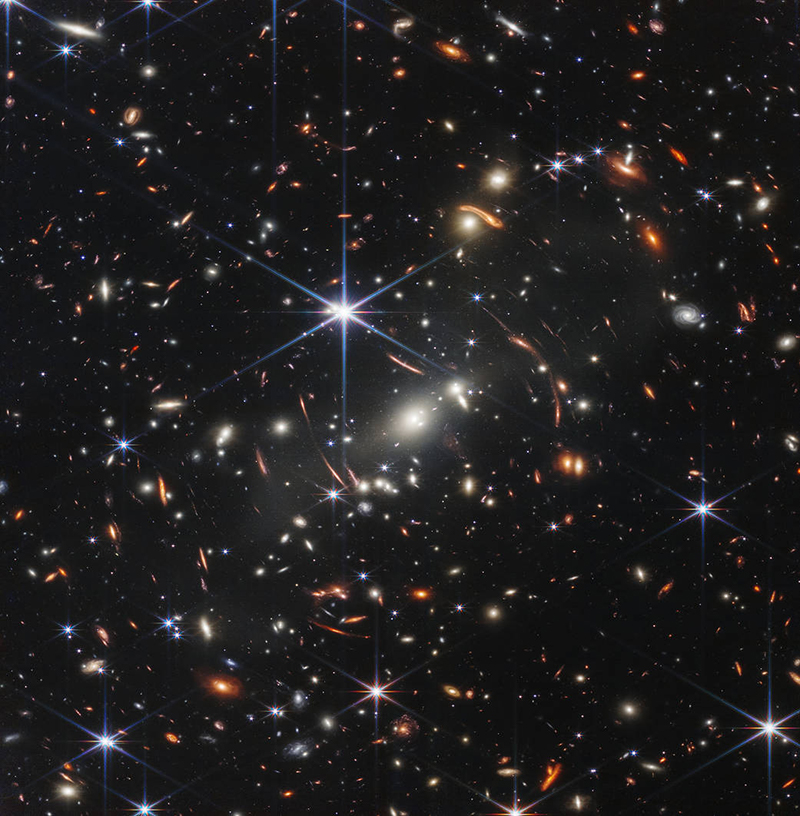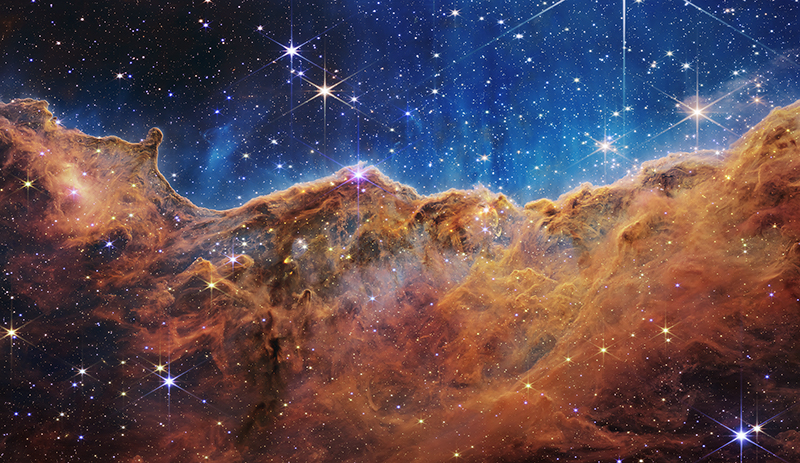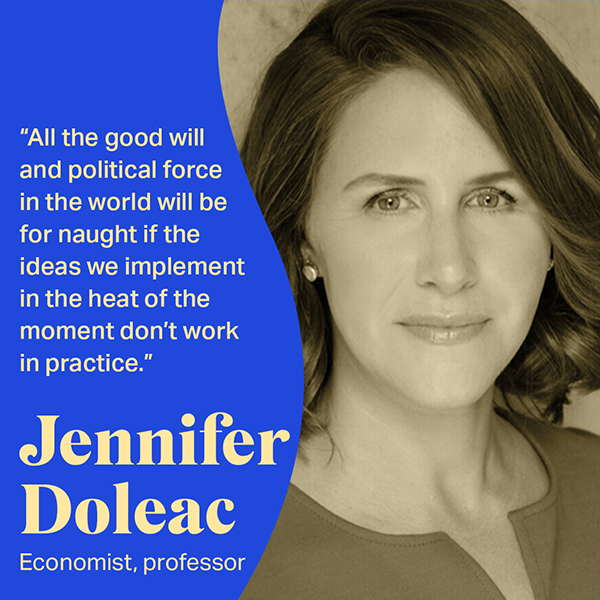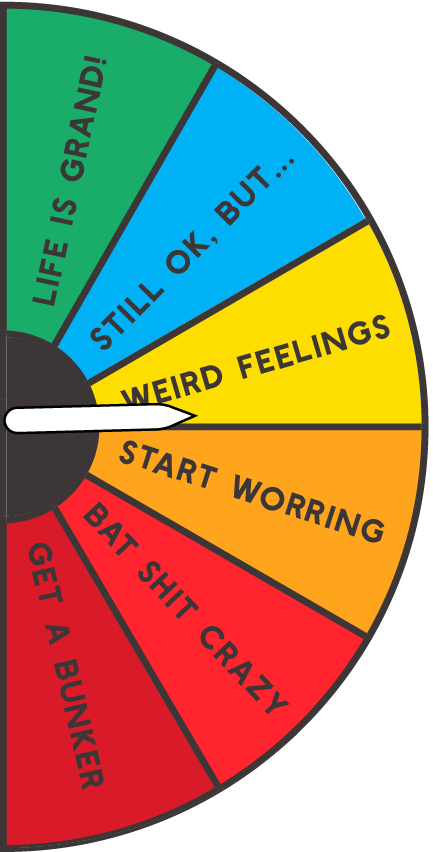Volcanoes are erupting in The Philippines, but on-fire Australia received some welcome rain. The Iran war cries have been called off and The Donald’s military powers are about to be hamstrung by the Senate. Meanwhile, his impeachment trial is starting, and we’re all on Twitter for a front-row seat.
What Could Go Right? Move over, Hubble
Mind-blowing space images from NASA’s bigger, better telescope
This is our weekly newsletter, What Could Go Right? Sign up here to receive it in your inbox every Thursday at 6am ET. You can read past issues here.
Move over, Hubble
We promised a break from the United States this week, and you know who delivered for us? NASA. The National Aeronautics and Space Administration dropped the first photos from the James Webb Telescope—the Hubble Telescope’s bigger, badder brother—and they are incredible.
The Webb Telescope lets us see farther into space and thus, farther back in time, close to the beginning of it. It has already found a galaxy that existed only 400 million years after the Big Bang. That’s old, considering that the Big Bang was almost 14 billion years ago. And that’s young, as The Progress Network (TPN) Member Gregg Easterbrook reminded us yesterday:

The first image NASA released, on Monday, shows thousands of galaxies that we’re able to see for the very first time. “This slice of the vast universe,” says the NASA website, referring to the photo below, “covers a patch of sky approximately the size of a grain of sand held at arm’s length by someone on the ground.”

Galaxy cluster SMACS 0723 | Credits: NASA, ESA, CSA, and STScI
The spiky shapes are stars. Everything else you see in the image is an entire galaxy. Remember the end of the movie Men in Black, when the camera starts zooming out from Earth, farther and farther away? We’re not quite at the giant universe creatures bowling, but this is the same idea. Harvard astronomy professor Alyssa A. Goodman puts the image in context in a one-minute video here. Heed the caption. The last ten seconds really are unmissable.
The Webb Telescope can also tell which molecules are which in the atmospheres of planets outside of our solar system. While the Hubble Telescope (and the lesser-known Spitzer Telescope, launched in 2003) only “sense” water and sodium, Webb can find carbon monoxide and dioxide, methane, and many substances, “some of which can hint,” says Science magazine, “at a planet’s potential habitability.” With Webb, astronomers will “be able to probe the atmospheres of every kind of planet,” the article goes on, “from hot Jupiters, through mini-Neptunes, to rocky planets like Earth.”
You can see all of the released images on NASA’s website. We also liked this slider from Vox that shows the difference in quality between the Hubble Telescope and Webb. And TPN Member James Pethokoukis explains the downwind benefits, including economic and cultural ones, that megaprojects like Webb have in his newsletter.
Briefly back down to Earth
Three things stalking the US—the baby formula shortage, gas prices, and the specter of a recession—are easing, at least for now.
The Abbott formula plant in Sturgis, Michigan, first closed after a Food and Drug Administration (FDA) inspection and then closed a second time due to flooding, has resumed production. That, plus the decision to let overseas manufacturers sell their baby formula in the US beyond the current shortage, means that life should get a bit easier for families in the short and long term. Hey, FDA, can we allow European sunscreen next?
Our non-city-dwelling readers might have noticed that gas prices have reached their peak (on June 14, specifically) and are expected to keep falling in the coming days and into August, barring any unexpected events. (By the way, we just discovered @GasBuddyGuy, who does nonpartisan tracking of gas prices, and he’s awesome. It’s his graph linked to above.)
“Did the growing chorus of doomsayers predicting an imminent economic recession jump the gun?” asks The Dispatch newsletter in their coverage of June’s better-than-expected jobs report. The labor market is still expanding, in almost every sector. It doesn’t mean we’re out of the woods for a future recession, but it does mean it’s still a good time for job hunters.
And in one more piece of FDA news, pharmaceutical company HRA Pharma is the first to apply to sell its birth control pill over the counter in the US.
Before we go
Scientists think that T-rexes’ tiny arms may have helped with sexy times. And that’s all we have to say about that.
Below in the links section, dolphins in New York, whales in Antarctica, fewer deaths in disasters, and more.

🎧 The New Space Race (Reprise)

Last month on the What Could Go Right? podcast, we spoke with Executive Director of the Inter Astra group and 26-year Marine Corps veteran Ché Bolden about the future of space. With all the big space talk this week, we’re revisiting that conversation. | Listen to the episode
Read the full transcript here.
Progress, Please
(Found good news? Tweet at us @progressntwrk or email.)
Other good stuff in the news 🐬
Environment:
- Tanzania’s new electric rail will help it cut carbon emissions | Quartz
- US judge throws out rollbacks on endangered species | AP
- New York City’s surrounding waters are so clean that dolphin sightings have become common | The Wall Street Journal
- A whale feeding frenzy in Antarctica signals a conservation success | The New York Times
- Dead solar panels are about to become a lot more valuable | The Verge
- Revolutionary new Swiss ‘water battery’ will be one of Europe’s main renewable sources of energy | Euronews
- ‘Extinct’ parrots make a flying comeback in Brazil | The Guardian
- UK energy bills to drop next year thanks to record-breaking investment in renewables | Euronews
Science & Tech:
- Why disasters are getting more severe but killing fewer people | Vox
- The best electric cars: A guide to green EVs | Bloomberg
- New CRISPR tool protects against viruses without making any DNA cuts | Singularity Hub
- All-electric ‘seagliders’ could soon serve Hawaii | Axios
- The cosmos can kill us in many ways. But the James Webb Space Telescope can help save us | Freethink
Politics & Policy:
- US hospitals must provide abortion services if the life of the mother is at risk | AP
- Romania fast-forwards its coal exit to 2030 | Europe Beyond Coal
- Medical debt is being wiped off credit reports | The Wall Street Journal
Covid & Public Health:
- Congo declares end to latest Ebola outbreak in less than 3 months | Healio
- Guinea worm disease is close to being eradicated | Our World in Data
- FDA allows pharmacists to prescribe Paxlovid Covid treatment | Axios
- Universal flu vaccine enters Phase 1 trials | Freethink
- Doctors are finding new hope in treatments for pancreatic cancer | USA Today
Society & Culture:
- Startups are rebelling against South Korea’s toxic work culture | Rest of World
- The largest ever exhibition on African fashion just opened in London | The New York Times
- Is the world really falling apart, or does it just feel that way? | The New York Times
- Hope: The secret weapon of democracy protection | Lucid
TPN Member originals 🧠
(Who are our Members? Get to know them.)
- How to rein in an out-of-control judiciary | James Fallows
- What motivates mass shooters to do the unthinkable? | David Brooks
- The West’s Ukraine strategy is in danger of failing | Fareed Zakaria
- David French on abortion | Yascha Mounk
- My love letter to you after Roe | Valarie Kaur
- When Republicans backed Herschel Walker, they embraced a double standard | John McWhorter
- Japan’s ‘JFK’ moment: Shinzo Abe assassinated | Ian Bremmer
- The American mass murder | Diane Francis
- It’s time to streamline the hiring process | Tyler Cowen
- Our ‘uniquely stupid’ decade | Jonathan Haidt
- Why recruiters should stop ‘fetishising’ elite universities | Scott Galloway
- The good that can come from a crisis | Ian Bremmer
- Space-based solar power with Ali Hajimiri, codirector of the Space Solar Power Project | James Pethokoukis
- The magic of a little danger | Arthur C. Brooks
- Should machines replace mathematicians? | John Horgan
- A relative taste of freedom in Afghanistan | Faisal Saeed Al Mutar
- Scientists found a simple way that kids make friends. Can it work for adults, too? | Jason Feifer
- The Ukraine war is about to enter a dangerous new phase | Thomas L. Friedman
Department of Ideas 💡
(A staff recommendation guaranteed to give your brain some food for thought.)
What a reckoning at the Supreme Court could look like | The New York Times
What might the court look like if it were designed for this era? What reforms would make the court’s judgment more, rather than less, trustworthy?
Why we picked it: The United States has reformed the Supreme Court in the past. Why not do it again now? These ideas, that go beyond court packing, are worth chewing on. —Emma Varvaloucas
New Member Alert

Jennifer Doleac is an associate professor of economics at Texas A&M University and the president of Doleac Initiatives, which encompasses several ventures related to criminal justice research and policy. She is the director of the Justice Tech Lab, codirector of the Criminal Justice Expert Panel, and host of the Probable Causation podcast. She is also a research fellow at IZA and a senior fellow at the Niskanen Center.
Read an interview with Jennifer on how to prevent gun deaths without gun control.
Until Next Time
Are we living in a simulation bird?👇


